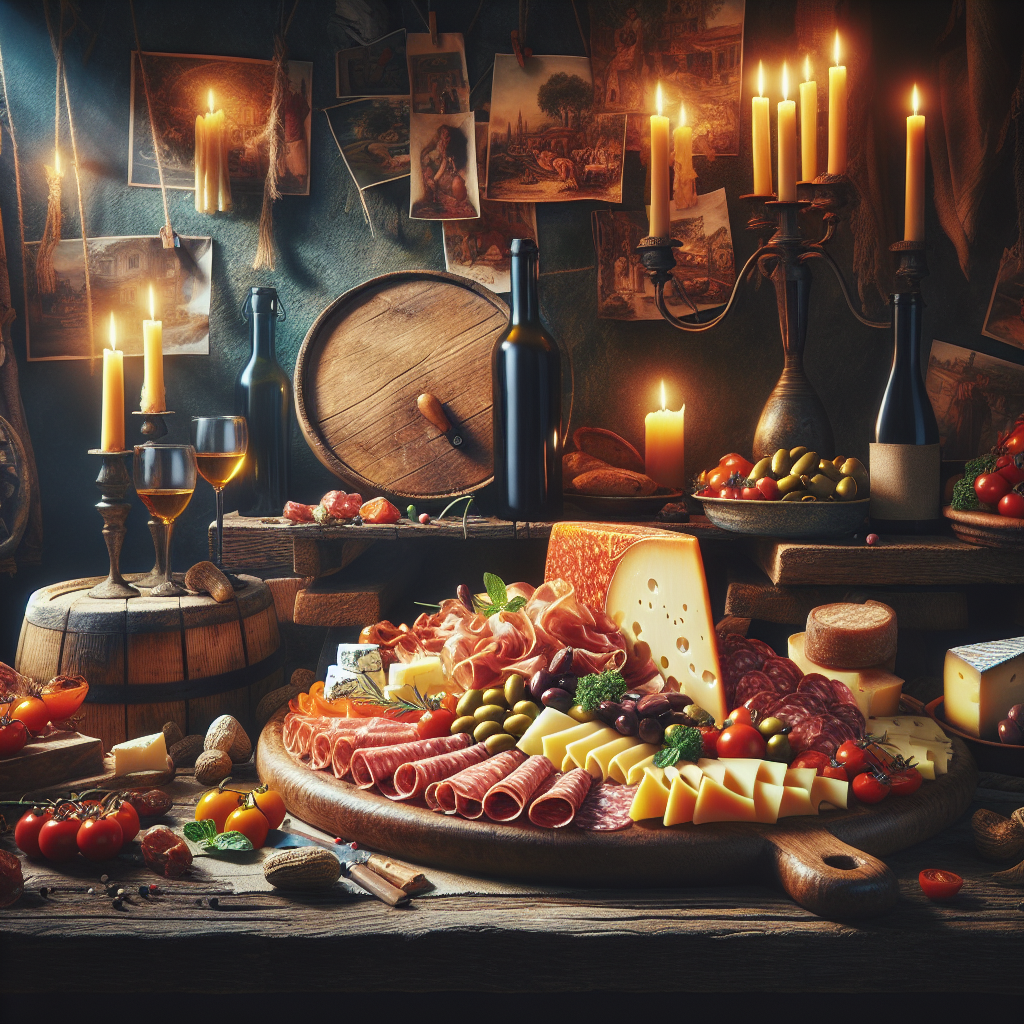Immerse yourself in the rich heritage of Italian cuisine as you explore the legacy of Italian trattorias. These charming and rustic dining establishments offer more than just delicious food, they transport you to different regions of Italy through their unique flavors and traditional dishes. From the hearty pasta dishes of Tuscany to the seafood-focused menus of the coastal regions, each trattoria showcases the distinct regional flavors that make Italian cuisine so beloved around the world. Join us as we take a culinary journey through Italy and discover the vibrant tapestry of flavors that define the legacy of Italian trattorias.

What is a Trattoria?
A trattoria is a traditional Italian dining establishment that offers a casual and relaxed atmosphere for patrons to enjoy rustic and regional cuisine. It is a place where locals and tourists alike can gather to savor authentic Italian dishes prepared with locally sourced ingredients. Trattorias have a rich history and play an important role in Italian culture, serving as a hub for community and family gatherings.
Origin and Definition
The term “trattoria” originated in Italy and is derived from the word “trattore,” which means “to treat” or “to deal with.” In the early days, trattorias were modest establishments that offered simple, homemade meals to locals and travelers. They were often run by families, passing down recipes and traditions from generation to generation.
A trattoria differs from a restaurant in that it provides a more intimate and traditional dining experience. It is characterized by its warm and welcoming atmosphere, where patrons are treated like family. Unlike a formal restaurant, a trattoria encourages interaction between guests and the chefs, creating a friendly and personalized experience.
Characteristics of a Trattoria
Trattorias are known for their rustic ambiance and decoration. The interior design often features vintage elements such as wooden furniture, exposed beams, and stone walls. These traditional touches create a cozy and charming atmosphere that transports guests to the heart of Italy.
One of the defining characteristics of a trattoria is its focus on regional flavors. Each region in Italy has its own culinary traditions and specialties, and trattorias pride themselves on showcasing these unique flavors. From the hearty dishes of the North to the vibrant flavors of the South, a trattoria offers a culinary journey through Italy’s diverse food culture.
Trattorias also embrace the farm-to-table philosophy. Locally sourced ingredients are the backbone of their menus, ensuring freshness and supporting local farmers. The seasonal nature of Italian cuisine is celebrated in trattorias, with menus changing to reflect the availability of ingredients. This commitment to using the best and freshest produce elevates the dining experience and adds depth to the flavors.
Historical Significance
Trattorias in Ancient Rome
The origins of trattorias can be traced back to ancient Rome, where the concept of a communal dining space first emerged. These establishments, known as “popinae,” served as meeting places for travelers and locals to gather, eat, and socialize. Much like modern trattorias, they offered simple meals and a warm environment for people to come together.
The popinae of ancient Rome laid the foundation for the trattorias we know today. Their focus on communal dining and hospitality became deeply ingrained in Italian culture and continues to be cherished in trattorias across the country.
Evolution and Spread in Italy
Trattorias became more prominent during the Renaissance period when Italy experienced a cultural and culinary revival. As Italians embraced a renewed sense of national identity, the trattoria emerged as a symbol of rustic Italian culture and traditional cuisine.
These trattorias began to spread beyond their origin in Rome and became popular throughout Italy. Each region developed its own distinct style and flavors, influenced by local ingredients and culinary traditions. Trattorias became a way for people to connect with their regional heritage and celebrate the diversity of Italian cuisine.

Regional Flavors
North Italian Cuisine
In the north of Italy, the cuisine is characterized by rich flavors and hearty dishes. Trattorias in this region often serve classics such as risotto, polenta, and hearty stews. The use of butter, cream, and cheese is prominent, adding a decadent touch to the dishes. Pasta dishes like tagliatelle al ragù (Bolognese sauce) and tortellini in brodo (stuffed pasta in broth) are also beloved specialties.
The north is famous for its cured meats, such as prosciutto di Parma and bresaola, which often make an appearance on antipasti platters. Cheeses like Parmigiano-Reggiano and Gorgonzola are also common, adding depth and flavor to many dishes.
Central Italian Cuisine
Central Italy is home to iconic dishes such as pasta carbonara, amatriciana, and cacio e pepe. The cuisine is characterized by simplicity and the use of high-quality ingredients. Trattorias in this region prioritize fresh pasta, often served with light sauces made from tomatoes, garlic, and olive oil.
Seafood is a prominent feature of central Italian cuisine, with dishes like spaghetti alle vongole (spaghetti with clams) and baccalà alla romana (salted cod) being popular choices. The flavors tend to be delicate and well-balanced, celebrating the natural flavors of the ingredients.
Southern Italian Cuisine
Southern Italian cuisine is known for its bold and vibrant flavors. Trattorias in the south often feature dishes such as pizza Napoletana, lasagna, and eggplant parmesan. The use of fresh herbs, spices, and chili peppers adds a fiery kick to many of the dishes.
Seafood plays a significant role in southern Italian cuisine, with dishes like spaghetti alle cozze (spaghetti with mussels) and sarde a beccafico (stuffed sardines) being local favorites. The region is also famous for its cheeses, including buffalo mozzarella and provolone del Monaco.
Traditional Dishes and Ingredients
Antipasti
Antipasti, or appetizers, are an essential part of the Italian dining experience. Trattorias often offer an assortment of antipasti, allowing guests to sample a variety of flavors and textures. Common antipasti include bruschetta, crostini, cured meats, marinated vegetables, and cheese platters. These small bites provide a delightful introduction to the meal and set the stage for the courses to come.
Primi Piatti
Primi piatti, or first courses, consist primarily of pasta, rice, and soups. Trattorias take pride in their pasta dishes, offering a wide range of choices, from classic favorites to regional specialties. Whether it’s a plate of spaghetti al pomodoro or a comforting bowl of risotto, these dishes showcase the simplicity and elegance of Italian cuisine.
Primi piatti also include hearty soups like minestrone and ribollita, which are often enjoyed during the colder months. These dishes are typically packed with seasonal vegetables and legumes, providing nourishment and warmth.
Secondi Piatti
Secondi piatti, or main courses, feature a variety of meat, fish, and vegetarian options. Trattorias excel in preparing these dishes with care and expertise, creating flavors that delight the palate.
Meat lovers can indulge in classics such as osso buco (braised veal shanks), bistecca all Fiorentina (Florentine steak), or saltimbocca alla Romana (veal cutlets with prosciutto and sage). Fish and seafood enthusiasts can savor dishes like branzino al cartoccio (sea bass cooked in parchment paper) or pesce spada alla siciliana (Sicilian-style swordfish).
Vegetarians are also well-catered to in trattorias, with dishes such as eggplant parmesan, caponata, and stuffed peppers often on the menu. These vegetarian options showcase the abundance of fresh vegetables and herbs used in Italian cooking.
Dolci
No Italian meal is complete without indulging in dolci, or desserts. Trattorias offer a variety of sweet treats, ranging from classic favorites to regional specialties. Tiramisu, panna cotta, cannoli, and gelato are just a few examples of the delightful desserts that await.
Desserts in Italy are often made with high-quality ingredients, ensuring that each bite is a taste of pure decadence. Trattorias take pride in their desserts, with many establishments crafting their own creations or using family recipes passed down through generations.

Farm to Table Philosophy
Locally sourced ingredients
A key aspect of the trattoria experience is the use of locally sourced ingredients. Trattorias aim to support local farmers and artisans by showcasing the best of what the region has to offer. This commitment to local sourcing ensures freshness, flavor, and supports sustainable farming practices.
By using ingredients that are sourced from nearby farms, trattorias strengthen the connection between the community and the food they enjoy. It allows patrons to taste the true essence of the region, creating a more authentic and memorable dining experience.
Seasonal menus
Trattorias embrace the seasonal nature of Italian cuisine by offering menus that change throughout the year. This change reflects the availability of ingredients and allows trattorias to feature dishes that showcase the best of each season.
Seasonal menus not only provide variety and excitement for diners but also support sustainable and responsible dining practices. By featuring ingredients that are at their peak, trattorias ensure the freshest flavors and support local farmers who rely on seasonal growing cycles.
Importance of Family and Community
Role of Trattorias in Italian Culture
Trattorias hold a special place in Italian culture, as they are not just places to eat but also hubs for community gatherings. These establishments often have a familial atmosphere, where guests are made to feel welcome and valued.
In Italy, dining is a social experience that brings people together. Trattorias provide a space where families, friends, and neighbors can come together to enjoy a delicious meal, share laughter, and spend quality time together. They serve as a meeting point and a place to forge and strengthen bonds within the community.
Generational Recipes
Trattorias are known for their dedication to preserving traditional recipes that have been passed down through generations. These family recipes are treasured and serve as a testament to the rich culinary heritage of Italy.
Many trattorias take pride in using these generational recipes, ensuring that each dish is prepared with the same love and care as it was decades ago. Through these recipes, trattorias preserve the flavors and techniques that make Italian cuisine so beloved around the world.
Rustic Ambiance and Decoration
Warm and Welcoming Atmosphere
One of the defining characteristics of a trattoria is its warm and welcoming atmosphere. From the moment you step inside, you’re enveloped in a sense of comfort and familiarity. The staff greets you with a smile, and the rustic decor creates a cozy ambiance that invites you to sit back and relax.
Trattorias often have an open kitchen, where you can catch a glimpse of the chefs at work. This transparency adds to the overall experience, making you feel like you’re part of the culinary journey. The combination of good food, friendly staff, and a cozy ambiance creates a welcoming environment that makes you feel right at home.
Traditional Interior Design
Trattorias embrace traditional interior design elements that reflect Italy’s rich cultural heritage. Exposed brick walls, wooden beams, and vintage furniture all contribute to the rustic charm of these establishments. These touches of tradition create a sense of authenticity that transports you to the heart of Italy.
The decor often includes vintage photographs, artwork, and decorations that celebrate Italian culture and history. Whether it’s a picture of an iconic landmark or a painting of a scenic countryside, these elements add depth and character to the space. The attention to detail in the interior design enhances the overall dining experience, making it truly memorable.
Trattoria Dining Experience
Casual and Relaxed Environment
One of the appeals of dining in a trattoria is the casual and relaxed environment it offers. Trattorias are the antithesis of formal dining establishments, emphasizing a laid-back approach that encourages patrons to unwind and enjoy their meal at their own pace.
There’s no need to worry about strict dress codes or complicated etiquette. Trattorias welcome guests in whatever attire they feel comfortable in, creating an inclusive and relaxed dining experience. Whether you’re dining alone, with friends, or with family, the warm and friendly atmosphere of a trattoria ensures that everyone feels at ease.
Interaction with Chefs
Another unique aspect of the trattoria dining experience is the opportunity for interaction with the chefs. Unlike in traditional restaurants, trattorias often have open kitchens or chef’s tables where guests can watch the culinary magic unfold.
This direct contact between chefs and patrons allows for a deeper appreciation of the craft and creates a sense of connection with the food being prepared. It offers a unique opportunity to ask questions, learn about the culinary techniques used, and gain insights into the flavors and ingredients that make each dish special. The interaction enhances the overall dining experience, making it more personal and memorable.
Trattorias vs. Restaurants
Distinctive Features
While trattorias and restaurants both offer dining experiences, there are distinct differences between the two. Trattorias focus on providing a more casual and intimate atmosphere compared to the formal setting of a restaurant. Trattorias prioritize personal interactions and a warm ambiance, whereas restaurants may have a more structured and professional approach.
Trattorias often feature open kitchens and communal seating arrangements, fostering a sense of community and camaraderie among guests. Restaurants, on the other hand, may have a more individualized dining experience with private tables and a greater emphasis on fine dining.
Types of Establishments in Italy
Within the realm of trattorias, there are different types of establishments based on the size, menu, and style of service. There are traditional trattorias that have been serving Italian classics for generations, often run by families. They offer a more rustic and homey experience, showcasing the essence of Italian cuisine.
There are also modern trattorias that put a contemporary spin on traditional dishes, incorporating new techniques and flavors into their menus while still embracing the trattoria spirit. These establishments retain the warm and welcoming atmosphere but offer a more innovative and creative approach to Italian cuisine.
Regardless of the specific type, all trattorias share the common goal of providing a memorable dining experience that celebrates Italian culture, regional flavors, and the importance of community.
Preservation and Revival
Challenges Faced by Trattorias
Like many traditional establishments, trattorias face challenges in the modern world. Economic pressures, changing dining trends, and globalization all contribute to a changing culinary landscape. Trattorias must navigate these challenges while maintaining their authenticity and preserving the essence of Italian cuisine.
One of the challenges that trattorias face is the competition from fast-food chains and more modern dining establishments. These establishments often prioritize convenience and efficiency over the traditional values of a trattoria. Trattorias must find ways to differentiate themselves and highlight their unique qualities to attract and retain customers.
Renewed Interest in Traditional Cuisine
Despite the challenges, there has been a renewed interest in traditional cuisine and dining experiences in recent years. People are seeking out authentic and meaningful dining experiences that allow them to connect with food, culture, and community.
This renewed interest has created opportunities for trattorias to thrive and innovate. Trattorias that stay true to their roots, prioritize quality ingredients, and offer a warm and welcoming atmosphere have found success in attracting a new generation of diners.
The revitalization of traditional cuisine and the appreciation for regional flavors have also led to collaborations between trattorias and local producers. This partnership promotes the use of locally sourced ingredients and supports the local economy, creating a sustainable and vibrant dining experience.
In conclusion, the legacy of Italian trattorias is rooted in their dedication to preserving culinary traditions, regional flavors, and a sense of community. These establishments offer a unique and authentic dining experience, where guests can savor rustic cuisine made with locally sourced ingredients. Trattorias celebrate the diversity of Italian cuisine, from the rich flavors of the North to the fiery spices of the South. The warm and welcoming atmosphere, along with the opportunity for interaction with chefs, creates a memorable experience that captivates both locals and tourists. Despite the challenges they face, trattorias continue to be a proud symbol of Italian culture, preserving and revitalizing the rich heritage of Italian cuisine.

